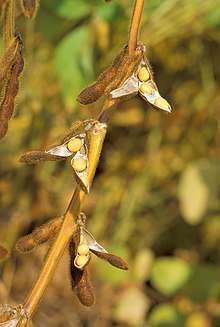Lunasin
Lunasin is a peptide found in soy and some cereal grains, which has been the subject of research since 1996 focusing on cancer, cholesterol and cardiovascular disease and inflammation.[1]
Discovery
Lunasin is a peptide that can be found in soy, barley, wheat,[2] and rye. It is found both in grains originating in the American continents as well as the old world continents.[3] This polypeptide was originally isolated, purified, and sequenced from soybean seed in 1987. Although uncertain about the peptide’s biological activity, the Japanese team of researchers described it as a 43-amino acid peptide, noting specifically the unusual poly (L-aspartic acid) sequence at the carboxyl terminus.[4][5] Subsequent research by Alfredo Galvez in the laboratory of Ben de Lumen at the University of California–Berkeley identified the peptide as a subunit of the cotyledon-specific 2S albumin.[6] The name of the protein was chosen from the Filipino word lunas, which means "cure".[7][8] Lunasin was patented as a biologic molecule in 1999 by de Lumen and Galvez.[9]
Medical research
The biological activity of lunasin was discovered by Galvez while working in the laboratory of de Lumen at UC Berkeley.[10]
There has been much research interest in the biomedical aspects of lunasin but the high cost of synthesizing lunasin made experimentation difficult.[11] This limitation has been overcome by the development of methods to isolate highly purified lunasin from soybean white flake, a byproduct of soybean processing.[12] In laboratory and animal experiments lunasin has shown anti-carcinogenic activity which suggests it may have chemopreventive potential.[13]
ALS treatment
In 2014, a local news program reported that a person with ALS named Mike McDuff had experienced dramatic improvements in their speech, swallowing and limb strength while taking a supplement regimen containing lunasin.[14] ALSUntangled[15] investigated and was able to confirm that Mike McDuff had progressive muscular atrophy a 'lower motor neuron' form of ALS, and really did experience dramatic and objective improvements.[16] Since one possible explanation for these improvements was the use of lunasin, Dr. Richard Bedlack of the Duke ALS Clinic decided to perform a clinical trial. Fifty people with ALS were put on the exact Lunasin containing regimen that Mike McDuff had taken and were followed for a year. The trial finished in September 2017. Unfortunately, there was no evidence that lunasin slowed, stopped or reversed ALS in any of the trial participants. Gastrointestinal side effects were more common than expected in trial participants, including cases of constipation severe enough to warrant hospitalization.[17] Bedlack concluded that lunasin was not a useful treatment for ALS and that Mike McDuff likely had some other explanation for his ALS reversal such as an ALS mimic syndrome or a genetic resistance to the disease.[18]
Impact on epigenetic changes
Lunasin was the first dietary compound with an identified epigenetic mechanism of action. This mechanism (histone acetylation) was identified by Alfredo Galvez in 1996 and patented in 1999.
References
- Fernández-Tomé, Samuel; Hernández-Ledesma, Blanca (February 2019). "Current state of art after twenty years of the discovery of bioactive peptide lunasin". Food Research International. 116: 71–78. doi:10.1016/j.foodres.2018.12.029.
- De Lumen, BO (2008). "Lunasin: A novel cancer preventive seed peptide that modifies chromatin". Journal of AOAC International. 91 (4): 932–5. PMID 18727555.
- Nakurte, Ilva; Klavins, Kristaps; Kirhnere, Inga; Namniece, Jana; Adlere, Liene; Matvejevs, Jaroslavs; Kronberga, Arta; Kokare, Aina; et al. (2012). "Discovery of lunasin peptide in triticale (X Triticosecale Wittmack)". Journal of Cereal Science. 56 (2): 510. doi:10.1016/j.jcs.2012.04.004.
- Odani, S; Koide, T; Ono, T (1987). "Amino acid sequence of a soybean (Glycine max) seed polypeptide having a poly(L-aspartic acid) structure". The Journal of Biological Chemistry. 262 (22): 10502–5. PMID 3611081.
- Lam, Yi; Galvez, Alfredo; De Lumen, Ben O. (2003). "Lunasin™ Suppresses E1A-Mediated Transformation of Mammalian Cells but Does Not Inhibit Growth of Immortalized and Established Cancer Cell Lines". Nutrition and Cancer. 47 (1): 88–94. doi:10.1207/s15327914nc4701_11. PMID 14769542.
- "A novel methionine-rich protein from soybean cotyledon: cloning and characterization of cDNA (Accession No. AF005030)" in "The Electronic Plant Gene Register". Plant Physiology. 114 (4): 1567–9. 1997. doi:10.1104/pp.114.4.1567. PMC 158452. PMID 12223786.
- "Lunasin: a Cancer Preventive Peptide in Seeds". University of California, Berkeley. Archived from the original on November 24, 2012. Retrieved November 29, 2012.
- Galvez, Alfredo F.; Chen, Na; Macasieb, Janet; de Lumen, Ben O. (2001). "Chemopreventive Property of a Soybean Peptide (Lunasin) That Binds to Deacetylated Histones and Inhibits Acetylation". Cancer Research. 61 (20): 7473–8. PMID 11606382.
- "Patent: Lunasin peptides, WO 1999015642 A1".
- De Lumen, Benito O.; Galvez, Alfredo F. (1999). "A soybean cDNA encoding a chromatin-binding peptide inhibits mitosis of mammalian cells". Nature Biotechnology. 17 (5): 495–500. doi:10.1038/8676. PMID 10331812.
- Ortiz-Martinez M, Winkler R, García-Lara S; Winkler; García-Lara (April 2014). "Preventive and therapeutic potential of peptides from cereals against cancer". J Proteomics (Review). 111C: 165–183. doi:10.1016/j.jprot.2014.03.044. PMID 24727098.CS1 maint: multiple names: authors list (link)
- Seber, LE, Barnett BW, McConnell EJ, Hume SD, Cai J, Boles K, Davis KR; Barnett; McConnell; Hume; Cai; Boles; Davis (April 2012). "Scalable purification and characterization of the anticancer lunasin peptide from soybean". PLoS ONE. 7 (4): e35409. Bibcode:2012PLoSO...735409S. doi:10.1371/journal.pone.0035409. PMC 3326064. PMID 22514740.CS1 maint: multiple names: authors list (link)
- Hernández-Ledesma B, Hsieh CC, de Lumen BO; Hsieh; De Lumen (April 2013). "Chemopreventive properties of Peptide Lunasin: a review". Protein Pept. Lett. (Review). 20 (4): 424–32. doi:10.2174/092986613805290327. PMID 23016582.CS1 maint: multiple names: authors list (link)
- https://www.youtube.com/watch?v=2U16BK61xic
- http://www.alsuntangled.org
- ALS 2014;15:622-626
- https://f1000research.com/posters/6-2118
- http://www.alsreversals.com/star.html
